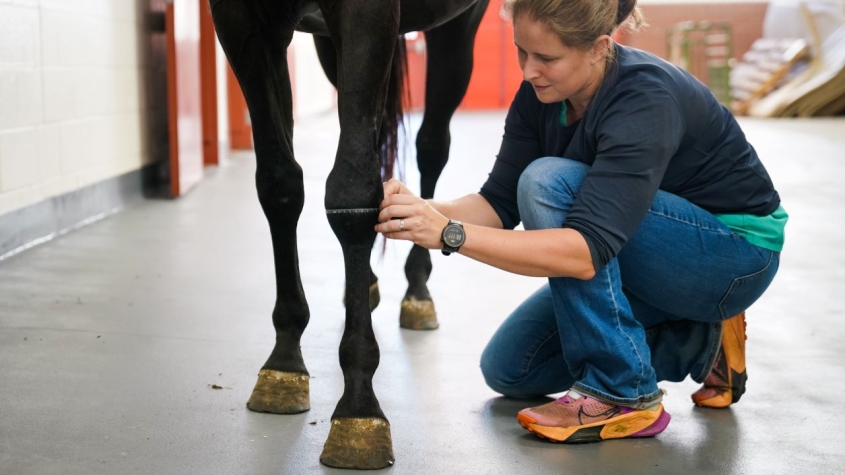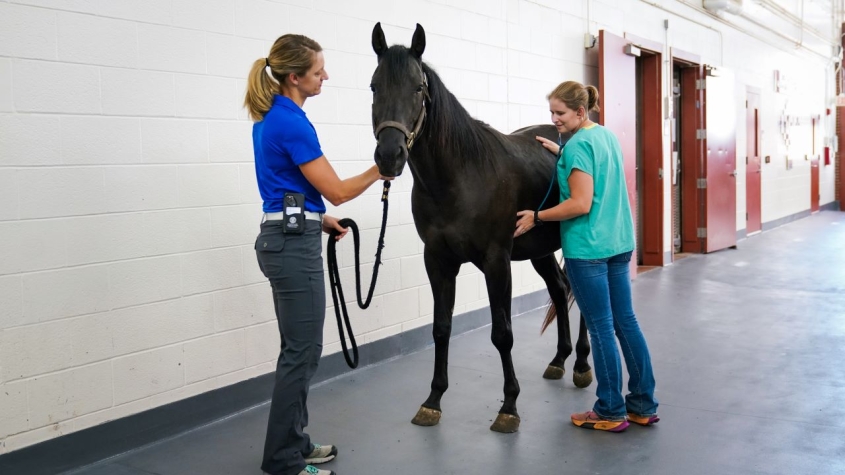Newly identified proteins could be key to catching arthritis early
A recent study has identified key proteins in equine joint fluid that could improve the early diagnosis and treatment of osteoarthritis (OA) in equines.
The study, published May 8 in the Equine Veterinary Journal, used advanced proteomics to analyze synovial fluid — the lubricating liquid found in joints — from horses with and without osteoarthritis. Research out of the lab of Heidi Reesink, Ph.D. ’16, and led by graduate student Erica Secor ’09, D.V.M ’13, discovered that several proteins — including alpha-2-macroglobulin and pregnancy zone protein — showed significant differences between healthy and arthritic joints.
This finding is an important step in furthering OA diagnosis and treatment, Secor says. “Most often OA is diagnosed based off clinical signs, then followed up with confirmation using radiographs,” she says. “One of the problems with this approach is that the changes seen by radiograph happen late during OA development, once the lesions within the joint are irreversible. Our best chance of stopping or slowing the progression of OA would be very early in the process, before radiographic changes are present and clinical signs such as lameness are mild and intermittent. However, catching cases at this point is very difficult.”
Another challenge in catching equine OA early is a technical problem: diagnostic methods usually rely on having the right antibodies to bind to specific proteins in a sample, which can then be measured. “While some antibodies can bind to proteins across several species, other times they are more species-specific, and there are many proteins in the horse that we may like to be able to measure, but don’t currently have the right antibody reagents to do so,” says Secor.
To overcome this logistical problem, Secor and her team used mass spectrometry to conduct a full molecular rollcall of all proteins in the joint fluid samples from horses with or without OA.
“The beauty of this technique is, not only do we not require any species-specific reagents, but we also don’t need to go into the experiment with specific targets in mind,” Secor says. “With this technique we can get an idea of all the proteins in the sample that we are testing, which can give us ones that we wouldn’t even know to look for. “
Most notable was the upregulation of proteins alpha-2-macroglobulin and pregnancy zone protein in diseased joints. While alpha-2-macroglobulin had been previously associated with OA in dogs and humans, pregnancy zone protein had not been described in horses before. While many of these upregulated proteins are considered anti-inflammatory and associated with maintaining joint health, Secor explains why OA samples would have them in higher levels: “It’s thought that the body responds to the initial trauma, injury, or joint degeneration by trying to increase the proteins needed to maintain joint health, but cannot overcome the degradative or inflammatory side, resulting in the progression of OA,” she says.
While the methods used this study aren’t immediately translatable to clinical application, the findings jumpstart an investigation into which markers should be used for a stall-side diagnostic tool.
“These findings could pave the way for a simple diagnostic test using synovial fluid to detect early-stage OA in horses,” says Secor. “Early intervention is key to preserving joint health and prolonging athletic careers.”
Written by Lauren Cahoon Roberts







